The ads above are Google-sponsored.
Clicking on them at every visit helps support this website!
Clicking on something inside an advertisement helps even more!!
SIDE-STANDS AND CENTER-STANDS:
Stock BMW. Farley, Brown, Surefoot, Migsel,
Flying Tpot, etc. Reynolds Ride-Off center-stand.
Available Engine stud lengths.
/5 sidestand pins. Problems and complaints &
repairing side-stands and center-stands.
© Copyright 2021, R. Fleischer
https://bmwmotorcycletech.info/FarleyBrownSurefoot.htm
79A
Side-stand complaints/comments:
Comments and complaints about side-stands are widespread, ....& hardly just for BMW's. Bending, hard to deploy, not enough angle, too much angle, automatic retraction, not automatic retraction ...and lots more. For BMW Airheads, many install other (aftermarket) side-stands and many modify the stock ones. Sometimes modifications or aftermarket items cause additional or other problems.
At my BMW shop, I would hear complaints now and then, and many a time we would get requests to check the customer's bike for the sidestand, pivot, etc., to be sure they were in good condition, and sometimes we were asked to modify side-stands for a customer or install aftermarket side-stands ...and some center-stands were also modified, some aftermarket ones too. THINK, carefully, before modifying either, or adding aftermarket products. Very lengthy 'threads' (conversations) on these subjects are in the archives of the Airheads LIST.
Extending/enlarging the base/footprint of the side-stand is common. I have done quite a few of those, sometimes modifying the base for a rear-wards facing and long 'boot grabber'. Sometimes all that is needed is to weld or otherwise make a tang for your boot, ....at other times something more elaborate was done.
Be very cautious about getting on & off the bike. If you have a short inseam, like I do, try to NOT put any side weight on the bike ...that will tend to wear the bushing & bend the stand, etc. DO NOT sit on the bike while it is on the side-stand. Be sure the stand extends fully & stops extending where it should. Some bike models, such as some K bikes, have a cable or linkage for mechanical retraction when the clutch lever is pulled in & it is best to lean the bike a bit, or more, to the right, before pulling in the clutch. Others have a side-stand operated switch, or even both, so be sure the mechanisms are properly adjusted.
If your Airhead tends to burn some oil in the exhaust upon first startup, try this commonly known method of engine shutdown:
Lean the motorcycle to the right for a few seconds during engine shutdown, and consider leaning it a bit more to the right after the engine stops, and hold that position a few seconds. Then, if using the sidestand, lean it to the left while demounting. Avoid pressuring the sidestand unnecessarily by your body weight. Use of the center-stand is usually preferred.
Back to sidestand use problems:
If the stand and bushing, retraction, switch, ...etc., are OK, there are numerous ways of improving side-stand operation. Extending the stand, increasing footprint area in a way that affords more resistance against sinking-into-tarmac-and-sand, etc.
For those having limit inseams, modifying the seat so it is narrowed at the front area will almost always improve your getting your foot down to the ground...and the stand too. Some will modify their riding boot tips.
Unless you have a dire need, I strongly suggest you DO NOT modify the suspension to make the bike sit lower. That will open a can of worms, including for the center-stand AND for handling.
WARNING: If you leave your non-automatic-retracting side-stand down when you take off from a stop; or, you have a failed spring so the stand is down; or, for whatever other reason it is down; ... you can get into an accident, when turning/leaning left. BMW, as well as other makes, have made changes, probably after being sued. One maker of a device to defeat the stock automatic sidestand was forced out of business...and became somewhat of a hermit, I was told:
http://forums.bmwmoa.org/showthread.php?32266-R100GS-Fans-Schneider-s-Inc-Forced-Under-By-Lawsuit
I am only reporting in this article on various side-stands & center stands that are available and/or that I know about, on installation & usage problems, as I know about such. In many instances I am relying on reports/comments/photos from others. You are on your own for any modifications. It is usually safer to use the factory setup, particularly on later models with safety features. I make no specific recommendations for or against. You must use your best judgment, ....you are the responsible party, not me.
Many Airheads were designed, manufactured, and shipped to the dealership having side-stands that come up automatically when there is no weight on them. Some other motorcycles have switches on the side-stands or a cable mechanism & you cannot start the engine, or put it into gear, with the side-stand down, etc. Some motorcycles have rubber bumpers on the side-stands that push the sidestand upwards if contacting the ground. These various things are generally safety items. Defeating such features can be hazardous to your health & that of anyone around you if you have an accident.
Some Airheads have a side-stand mount anchor plate for the spring that can be rotated (after loosening the front motor mount stud), & thus the side-stand can be the stock automatic retracting type; or, one you must manually raise. Be aware of what you have; be careful & cautious, stock or otherwise. Consider what could happen if you defeat the factory safety feature(s) ...as someday you LIKELY WILL forget the side-stand is down. It happened to me, and I was lucky to not dump the bike...and me.
Later Airheads, stock sidestands, Service Information Bulletins:
BMW has had at least two bulletins on the side-stands of the later Airheads. The first was 46-006-83 (2076) & said that during the 1983 production year, the bell/barrel bushing was eliminated & the frame stop was modified. The result was more lean angle, & also the automatic folding-up of the side-stand ...as the weight of the motorcycle was lifted off it. The modification fit the 1981 & later, but not the G/S and ST.
Kits were available, 46-53-2-302-026 (maybe was actually -062, which became 46-53-2-302-003, which became 46-53-1-454-750). For the R65 and R65LS the kit was 46-53-2-302-061 which later became 46-53-2-302-001, and that became 46-53-1-454-751.
Some of this confusion came about because a later bulletin, 46-029-90 (2419) applied to the 1981-1984 model year. Again, kits were offered. These included a mess of parts including two shouldered bushings that had to be installed squarely (a bolt and washers will do it just fine), and the thicker shoulder bushing goes at the bottom. The kit was 46-53-1-454-750; and 46-53-1-454-751 for the R65.
NOTE: The 83+ models used a bushing, 46-53-2-302-000.
Install the side-stand before the left front spacer. If you want to work on the side-stand, off the bike, remove the left side front motor mount stud, and knock it through to at least flush with the engine.
BMW has available replacement bushings, etc., for the side-stands. Side-stand angle will become more & more to the left if the sidestand parts bend or are worn.
Quite a few models of BMW Airheads can be 'adjusted' to be self-retracting, or not self-retracting. The adjustment is the spring perch that is between the frame and motor, it can be rotated easily on those models. Think carefully before doing such a modification ...the automatic return feature, hated by many folks, is a safety feature. Think about Schneider's modification kit, and what happened to Schneider.
BMW side-stands are not all the same, don't have the same features for retraction, lengths, angles, fitments, etc. For many, if not most riders they work OK. Riders with longer inseam measurements have the least trouble in reaching the sidestand when it is deployed. For some ...with long or, especially, short inseams ...there are problems or perceived problems. Some people dislike not being able to see the deployed or deploying side-stand. Problems are common for those with short inseams and automatic retracting side-stands. One is during straightening up the bike to vertical and having to try to reach and thus operate the side-stand for retraction; usually this is only on the non-auto-retract side-stands...but some side-stands will not begin to retract by themselves until you pull them back a bit. The other rather often complained-about problem is when stopping ....and wanting to put the bike on the side-stand. You may need to slide rather far off the seat (especially if the seat has a relatively wide front section, and/or is tall) in order to push the side-stand far enough forward to have it at or close to its forward limits ....and, at the same time, lean the bike onto the side-stand to keep it from retracting. The process may be quite disconcerting and/or uncomfortable. You certainly don't want to take the chance of dropping the bike. You may have to lean quite a bit....and even then, perhaps rock the bike backwards while the side-stand is touching, to ensure the stand is fully forward. This is the problem most complained about, and is why the Brown side-stand was so popular and remains so.
Sometimes there is a worn or bent side-stand. If worn, they can have a bushing installed & BMW has bushings for those versions that have replaceable bushings; plus, some early models had pins and there is an oversize available. If need be you can also have a bushing machined.
For some, just modifying the existing side-stand with a tang, so your boot tip can grab it, is all that is needed. Some do not like the small footprint of their side-stands & that is not difficult to fix, although some just carry a little plate of some sort, which can work well on soft ground or hot (from the sun) asphalt. For those with short-inseams, just reaching some of the BMW side-stand models, even with a fair sized tang, is a problem. Narrowed front area of the seats can help considerably, with further help if the seat is lowered. Your author, Snowbum, has a 29" inseam, but happens to like the comfort of the Russell "Day-Long" saddle, which, if stock Day-Long, is usually a bit tall and also wide at the front in practical use. Snowbum finds it difficult to extend the side-stand far enough so the bike weight will ensure the side-stand is fully-down and locked in place (usually by rocking the bike backwards slightly to be sure the side-stand is fully in place. Snowbum has tried many types of side-stands. He has NOT tried the Surefoot, which may well be a good answer. Note that as I have aged, I am considerably less limber than I used to be, and hence the experimental modifications I have done, and I usually have at least one such shown in this article.
Quite a few riders are afraid their bikes will fall if they dismount without already having the side-stand in the fully-out position. Many try to deploy the side-stand from the seated position. Some will actually drop the bike....perhaps they can't 'see' the side-stand & can't tell whether or not it is fully deployed. I am not much in favor of extending the side-stand from the seated position, but I certainly understand it could be necessary at times. An example might be such as with a load on the passenger seat, hard to move one's legs, especially short legs, over a large package on the rear seat. I particularly do not like to see it done when the rider THEN dismounts, after having put not only the bike, but his WEIGHT on the side-stand by having his foot & weight on the left footrest. Sitting on your bike at any time with the side-stand deployed is NOT a good idea. Keep in mind that the stock side-stand, and some others, are not designed for excessive weight on them. Whatever method or side-stand you use, be careful, develop your own method & routine, and be sure the side-stand will not collapse or break.
Before getting into the photos & comments, note that none of the aftermarket stands, nor the stock stands, of the ones I have seen and used, are perfect. Be sure that you consider use of the center-stand, particularly if using a Reynolds.
One of the better side-stands Snowbum ever used on an Airhead was one he modified for an RT. It was a Brown type that was modified so the horizontal metal piece bolted to both the front & rear motor mounts and thus no clamp was on the exhaust pipe as the Brown side-stand was originally designed. A clamp can be slightly modified to fit over the frame member, and that will work very well. I had also changed the studs to slightly longer ones. Brown side-stands are not automatically retracting, so you had to remember & properly use that side-stand.
BE VERY CAREFUL USING SIDE-STANDS THAT HAVE EITHER WORN, OR THE DESIGN IS SUCH, THAT THE STAND WHEN EXTENDED AND THE BIKE LEANED OVER ON IT, SHOWS THE STAND QUITE WELL FORWARD...ON A VERY FORWARD ANGLE THAT IS. SUCH A STAND, IF IT IS NOT DETRACTED, IS VERY LIKELY TO DIG INTO THE GROUND/TARMAC/CEMENT SURFACE, AND MIGHT FLIP YOU WHEN YOU RIDE OFF.
See photos well below for variances on Brown type side-stands, etc. For safety purposes, I did one with a pair of added pegs that allowed an additional spring to be used (not that I ever heard of a Brown spring failing). The stand was heated red-hot; reshaped slightly; a plate for a foot added. Unfortunately I never took a photo. There are photos of a clamping modification later in this article; just not exactly the same as the one I did.
Below are photos of my last experimental attempt ... a version of an earlier idea I had. I was 80 when I did this ugly and crude modification; originally intending to make it work and then make a really pretty version. The first two photos are shown here in the brown primer paint, before final black painting. The sleeve was made on a lathe, with one end threaded for the hardware store item, a threaded adjustable length (threaded) furniture glide. These come in at least 2 'pedal' sizes, the one shown here is the larger version. Dream-up your own conversion. Surely you can do something nicer than I did in this version.
This entire side-stand extension cost me about $3 in parts. This modification was experimental. I have since figured out how to make this sort of modification even simpler, look nicer, and reduce its weight, but even this experimental version works well-enough for my short legs. I decided to put a common rubber rod tip onto the furniture glide. That helps my boot tip grab it when I am still in the saddle. I added a mild spring to the stock 2-spring structure at the forward end of the side-stand, for a better 100% return when it is up, because the metal added does have some weight, which the original springs (still in use) were not designed-for. NOTE that this is a truly crude version, and not intended to be duplicated.
.jpg)
.jpg)
The above experimental version is likely still on the bike (which I sold). I have not yet purchased and tested a Surefoot. I may yet do those things. I also may not! Heck, I might get other ideas...
Migsel, for GS bikes:
http://www.migsel.com/store/index.php?_a=viewProd&productId=99&review=read I have not yet had any experience with this item, so research carefully if you think you want one. It auto-retracts, or not (selectable) and length is also selectable.
BROWN Side-stand:
While the original mounting can work OK, see below photos, be sure the engine stud is torqued to 55 ftlbs, and that the clamp is not actually pressuring the pipe when the stand is deployed ...and I highly suggest you do not sit on the bike with the side-stand in use. Modification of the Brown stand mounting so that it is not clamped to the exhaust pipe at the Brown's forward end is a bit further down this article. Longer lengths of engine studs are listed near the end of this article.
Here is a photo of George Turski's Brown Side-stand as on his 1982 R100RT; George has a heat shield on his muffler.
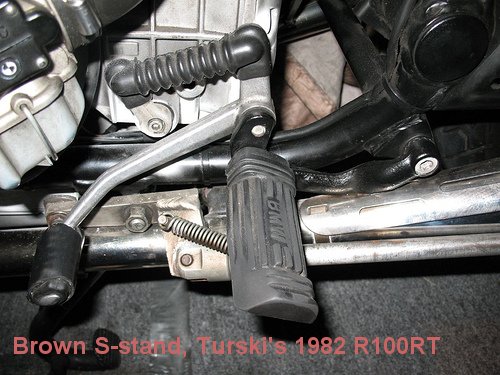
Below are five photos of a 1984 R100RT which Snowbum used to own & ride, which has both a Reynolds center-stand & the Brown side-stand installed. It also has the big footrest plates. See caution note under the photo, besides the note IN the photo!
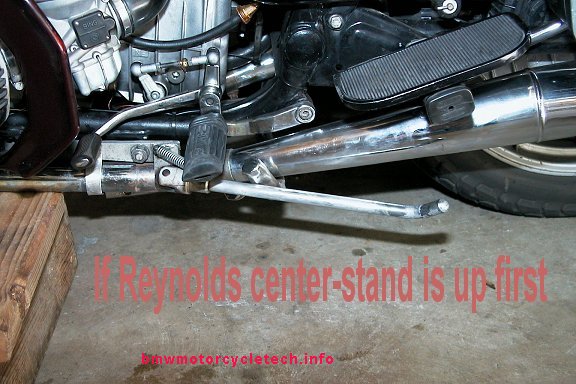
CAUTION! DO NOT use the side-stand as shown above!
If the Reynolds center-stand is put-up first, the Brown will be held outward, as shown; the Brown will contact the ground on very sharp turns. Avoid using the stands like this! The easy fix is to put the Brown up first, but there may be some interference problems. One person I met had heated the Brown stand with an oxy-acet welding torch and put a U into it, just to clear the Reynolds. This actually worked rather well for him. I've never done one like that myself. Any such heating would have to be done carefully and at enough red-heat, to avoid weakening the stand.
It is possible to modify the Reynolds tang. See much later photos further down this page, for a Farley side-stand with a modified Reynolds center-stand.
Another modification, if one has both the Brown & the Reynolds, is to use an oxy-acetylene torch & heat the left foot-tip area, so it will fit under the Brown. The result will be that the Brown will not stick downwards, when up. The above photo shows the unmodified setup with the Reynolds.
In the first below photo, the small hard-to-see red caption next to the rear tire says that the Brown is not touching the muffler anyplace. A closeup of that is located several photos further down.
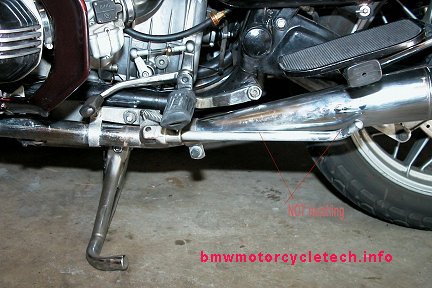
Below photo shows the Brown down, the Reynolds up.
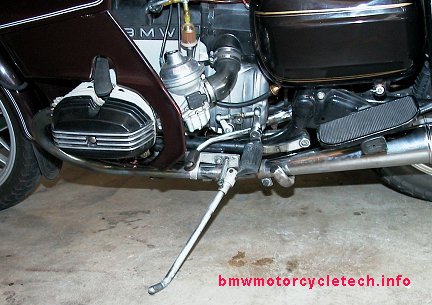
Below photo shows the Reynolds also down.

Below is a close-up photo of the Brown side-stand folded up-to, but not touching the muffler. In some installations the end may be sticking out too far, if so, you can modify the mechanical limit area where the hinged stand fits. Note what I said well above about modifying the Reynolds left tip ...that will allow the Brown to fit as if the Reynolds was not even there. You still have to remember which stand to put up first!

In the below installation, no exhaust pipe clamp is used, & using a few standard BMW parts, a very secure mounting can be made. This can be a decent modification; for twin low pipes, & some other piped models, etc., where no exhaust pipe clamping is possible for the Brown side-stand ...and, of course, if you do not like the original exhaust clamp mounting. The clamp may have to be reworked some (quite minor); but, on some bikes it will not fit. This modification is well worthwhile!
While the original mounting can work OK, see well-above photos ...be sure the engine stud is torqued to 55 ftlbs & that the clamp is not pressuring the pipe (if that is how your clamp is fitted) when the stand is deployed. I strongly suggest you do not sit on the bike with the side-stand in use.
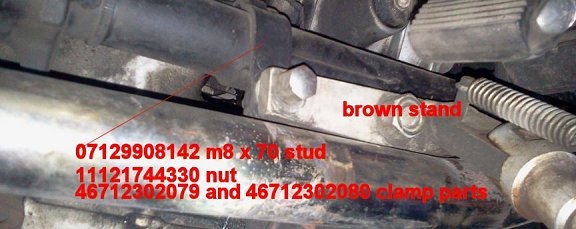
Farley Side-stand:
Farley's 616-896-8469. Robert VanFarowe; 2792 24th Ave.; Hudsonville, Michigan 49426 They come with longer rear engine bolt. Probably better than Brown's?? Reportedly fit better at the shift area, due to milled area. Robert Van Farowe also makes custom side-stands. He may be making engine mounting studs too. Two of the below photos show comparison between the Farley and the Brown.


The below photo, which I have enhanced as best I can, shows the Farley side-stand mounted on a 1983 R100RS. In order for the Farley to fit better when folded up (the bike also has a Reynolds Ride-Off center-stand), 3/4" was sawn off the foot tang of the Reynolds. Very difficult to see, but in this particular installation, Farley supplied a black crash-bar clamp, etc., which supports the front bolt area of the Farley side-stand, at the BMW frame point for the center-stand. This was done to avoid the problem of the Brown side-stand & potentially the Farley side-stand, from putting pressure on the exhaust header (if a clamp was used around the exhaust header, & fastened to the forward side-stand bolt). However, as you can see from photos well above, the exhaust pipe clamping problem with the Brown is easily solvable by adding a clamp of BMW parts, and possibly slightly modifying the clamp.
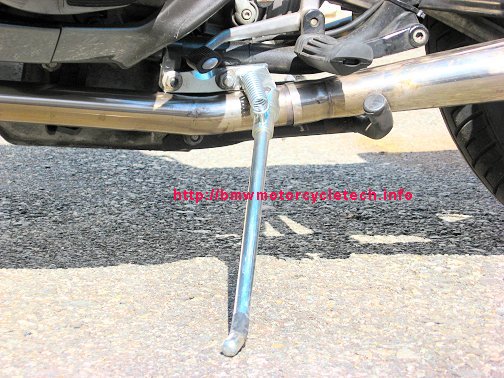
Surefoot Side-stand:
These were, in the distant past, normally quite well welded to the footpeg, which either is supplied or exchanged. The design has changed. There are various versions now, with various types of fitment. Look at the photos carefully!
The first set of photos (3), just below, are not all the same stand & installation. One spring, two springs, adjustable length, not adjustable length, etc.
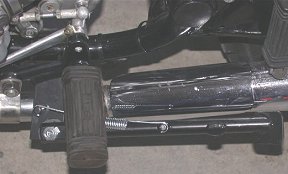
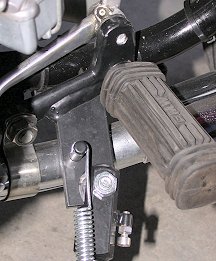
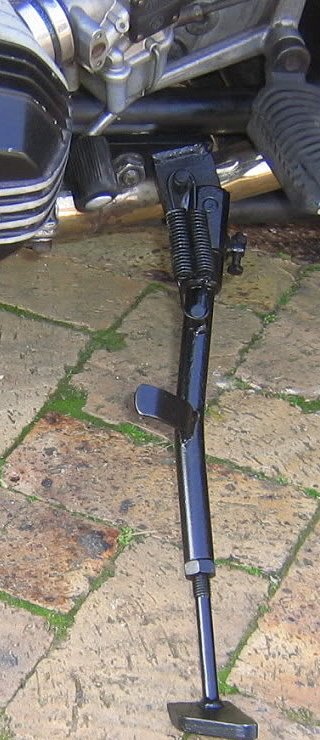
The following was reported in early 2012, & I have not personally inspected this side-stand nor the installation. If true, & the Surefoot design has been modified again, since my above information was prepared, be advised! I have edited this rather substantially; adding my own comments too.
The Surefoot side-stand (reported as for a 81R100RT) is ...or, was ...creating a few problems. The upper arm of the U-shaped bracket that grips the frame was bearing against the gearbox casing & preventing complete fastening of the engine mounting nut. The owner trimmed the bracket to fix that. The hole for the engine mounting bolt was so close to the welding on the angled flange, that he could not fit a standard flat washer under the nut. He replaced it with a thick spring washer, then found that the upper pin for the coil spring was bearing against the exhaust pipe. A trip of less than a mile heated the pin to the extent that the hook on the coil spring softened & straightened, causing the spring to fall away. Fortunately this happened in his driveway so he had the coil spring & could clearly see what happened. The Surefoot appears to have been modified several times by the maker & one change is that coil springs used to be on top of the leg (as seen in the pictures above (and also see my article 79B for commentary) have now been replaced with a single coil spring under the leg. And that is where the problem arises. The owner was not sure if the problem is the Surefoot or his exhaust headers, the origin of which is unknown to him. Snowbum says: I have no further information ...yet ...but if you are considering purchasing a Surefoot, ask questions! In March, 2016, I received information on some issues. Check your stand; and, be aware of these things. These are in my words, not his. He had a problem that the single underside spring needed lubrication to the upper hook, as it moves around the pin as the stand is deployed. Note that this is common to many springs on the Airheads, including the stock sidestand and stock center-stand ...the spring hooks area needs lubrication now and then. I have always recommended a moly grease.
More troubling to him ...and me ...is that the main tube of the the stand came loose of the forked mount. The leg spun around and was held on the bike by just the spring and nothing else. He saw that it didn't seem to have been welded at all. It looked like it was just held on by paint. He welded it back on and had no problems since.
The Surefoot is now available in quite a few models, and bolt onto the motorcycle. Investigate carefully. Some are adjustable for length. Here is one source for the various Surefoot stands, with many photos:
https://www.motorworks.co.uk/vlive/Shop/Parts.php?T=5&NU=15&M=20&Ct=MA&SbCt=BA_15_20_MA_45
See this photo too: http://i.ebayimg.com/images/i/131851178271-0-1/s-l1000.jpg
Just below are 4 more Surefoot photos. These were on a 1983RT, and the motorcycle also had a Reynolds Ride-Off center-stand.
The lean angle of the bike is adjustable because of the adjustable length foot. The owner informed me that the screw that limits the upward movement on his motorcycle has been replaced with a longer one and adjusted so that the retracted stand does not touch the bottom of the standard BMW panniers/hard bags. He also noted this is the Adjustable Surefoot, Motorworks, model FRA54750.
Note the use with the Reynolds Ride-Off center-stand. He said it can't be deployed with Surefoot UP...due to trying to get ball of foot onto the lever. This is quite obvious. He also said, that if uncomfortable to get off the bike with stands up, then deploy the sidestand, then, off the bike, deploy the center-stand.

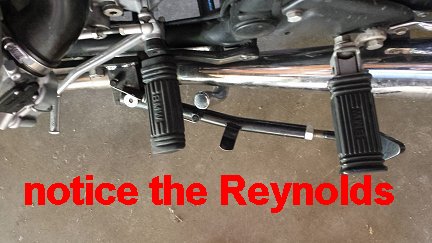
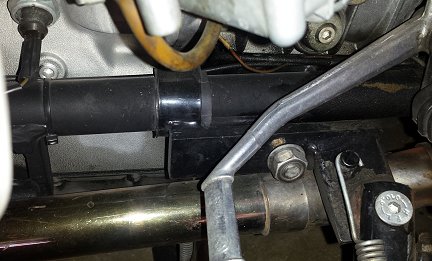
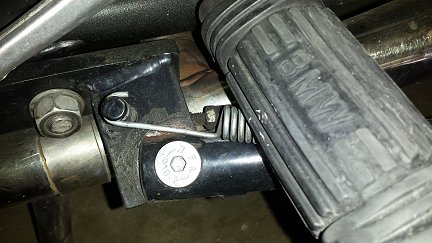
The owner of the above bike also supplied the below instructions, note it is for 1985+ Monolever bikes:
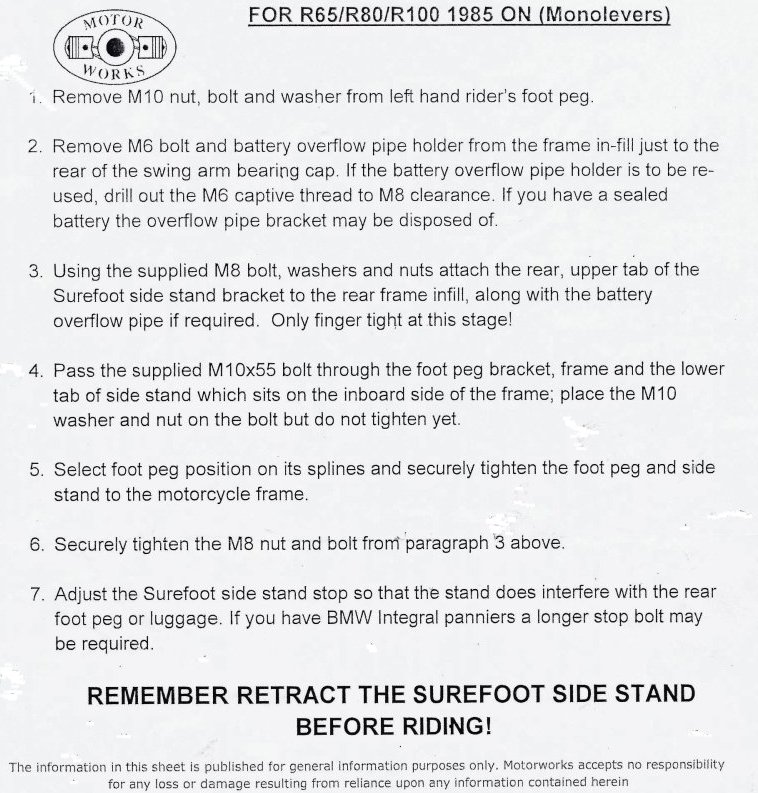
Below are 4 more Surefoot installations provided to me:
Another photo, this is one for the Monoshock models:
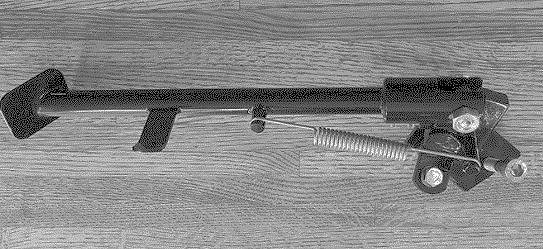
FlyingTpot Side-stand:
On 04/07/2013 when I first edited this section, FlyingTpot made side-stands just for the ST and GS models.On 09/04/2013, I received a message from Carl Santora of this company, who informed me that they not only make side-stands for the Monolever G/S, GS, ST, and Paralever GS; but, that they make them for other BMW twins, for years of 1955-1995, although they were not listed on the website.
Carl also said that, in his words, "Only the paralever GS sidestand is required to be deployed/retracted in sequence with the use of the centerstand." Well, I may have to take issue with that sentence of Carl's ...so, read on ....
Their website page is: http://www.flyingtpot.com/sidestands.htm. Be sure to scan all the way down that linked page, as some models are not listed at the top!
This side-stand fastens using the rear engine bolt. The rear of the mount fastens to the foot-peg bracket. The longer bolt for the foot-peg comes with the side-stand. Your heel will operate it; the lean angle for the bike is good & you can see the deployed stand. Like many aftermarket side-stands, it interferes with use of the center-stand, but I do not see this as a problem, just use it properly. See Carl's quote, above, however. Semantics???
Seems to be well-designed & constructed ...if somewhat massive. While not available for all BMW Airhead models, the idea is sound; you might be able to use this on other models than the one's the manufacturer says it fits ...and, you can ask about unlisted models.
It has been reported more than once that, at least on the R100GS, that you have to have the stand extended, to be able to fully retract the center-stand. One comment was that your should be a bit cautious, as you could bump the stand into your leg, when placing the R100GS on its center-stand.
Here are a few photos grabbed from their site:


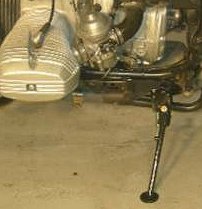
FlyingTpot does a lot more than side-stands. The URL to their main website is:
http://www.flyingtpot.com/main.htm
Click in the middle (on the 'eye'). They have saddlebags (Panniers) & mounts, do exhaust port repairs, etc.
SS side-stand, from Germany, for the R Mystics, etc., motorcycles:
Engine studs come from BMW in more than one length, see
https://bmwmotorcycletech.info/hardware.htm. You might need a longer stud if installing an aftermarket stand. Here is abbreviated information:
46-71-1-230-762, engine mount stud, 306 mm long.
46-71-2-311-725, engine mount stud, 315 mm long.
46-71-1-230-475, engine mount stud, 327 mm long.
There may be other sources for longer than stock engine studs, see, well above, at section: "Farley Side-stand:"
Stock (/5) BMW Sidestand & its pin:
The /5 side-stand fits on a pin that is pressed into the frame. BMW supplies the replacement pin as oversize, & you must ream the existing hole for a good interference fit. The part number is 46-51-1-231-233. Remove hyphens if using on-line fiche.
Later Airheads, stock sidestands, Service Information Bulletins:
BMW has had at least two bulletins on the side-stands of the later Airheads. The first was 46-006-83 (2076) & said that during the 1983 production year, the bell/barrel bushing was eliminated & the frame stop was modified. The result was more lean angle, & also the automatic folding-up of the side-stand ...as the weight of the motorcycle was lifted off it. The modification fit the 1981 & later, but not the G/S and ST.
Kits were available, 46-53-2-302-026 (maybe was actually -062, which became 46-53-2-302-003, which became 46-53-1-454-750). For the R65 and R65LS the kit was 46-53-2-302-061 which later became 46-53-2-302-001, and that became 46-53-1-454-751.
Some of this confusion came about because a later bulletin, 46-029-90 (2419) applied to the 1981-1984 model year. Again, kits were offered. These included a mess of parts including two shouldered bushings that had to be installed squarely (a bolt and washers will do it just fine), and the thicker shoulder bushing goes at the bottom. The kit was 46-53-1-454-750; and 46-53-1-454-751 for the R65.
NOTE: The 83+ models used a bushing, 46-53-2-302-000.
Install the side-stand before the left front spacer. If you want to work on the side-stand, off the bike, remove the left side front motor mount stud, and knock it through to at least flush with the engine.
BMW has available replacement bushings, etc., for the side-stands. Side-stand angle will become more & more to the left if the sidestand parts bend or are worn.
Quite a few models of BMW Airheads can be 'adjusted' to be self-retracting, or not self-retracting. The adjustment is the spring perch that is between the frame and motor, it can be rotated easily on those models. Think carefully before doing such a modification ...the automatic return feature, hated by many folks, is a safety feature. Think about Schneider's modification kit, and what happened to Schneider.
Center-stands:
BMW center-stands vary by year and model. 46-52-2-301-593 was the center-stand upgrade itself. Some books say that these are for upgrading 1979 through 1984. The kit for the R65 was 47-52-9-056-257 and, for the others, it was -256.
Both used 10 x 30 size, grade 12.9 bolts.
The kits fit 1979-1984.
The kits are NLA.
Best kit usage is 1981-1982, as center-stands were particularly poor those two years. 46-52-2-301-593 is the upgraded version.
The stock center-stands wear. The stops wear, the bolt fastener areas wear, and the bottom of the feet wear. ALL are fixable, without replacing the stand. Bushings, bolts, stops, all rather easily fixed/repaired/replaced, as one's year/model/situation requires. The bottom of the feet ...that is ...the area the stand rests on ...is also easy to fix, & if you modify that area with some welding-up (such as adding a metal piece on both L and R sides), & then grinding to make it look nice and smoothly blended-in, it works just fine. That is a fairly good fix, too, for when someone uses a stock stand & then puts a one-step-larger tire on front, because then, without that fix, or whatever, the front tire will also be on the tarmac, not just the rear, when on the center-stand.
ABUSE: (1) using as a ride-off; (2) putting bike on center-stand when seated on the bike; (3) failure to lubricate the pivot area.
Many center-stand problems are from wear in the bolt/bushing/stops areas....and can be repaired with new parts or a bit of welding and grinding, etc. However, the early eighties center-stands are notorious for being difficult to use. A nice fix for a worn pivot area is to drill the hole out & install a custom-made (or; commercially made ...seen these available in Stainless Steel...) shoulder spacer. I've made my own design for customer bikes on my lathe. Make these things of some sort of steel.
If your center-stand has problems with wear, at the lugs, at the mating parts, etc., ....often these can be repaired by welding or making bushings, or both, ....all sorts of various fixes are possible.
"Wear" includes the stops for the center-stand. The springs also wear, get weak, can break, and I highly recommend new side-stand & center-stand springs.
BMW did not mount the center-stands in the same manner for all models & years. Some have a shoulder bolt, threading into a welded-on frame lug; some use a tapered allen headed bolt & a Nylon insert type of nut; with a shoulder top hat type spacer, etc. Before doing/taking any of my suggestions, be sure what type you are dealing with.
There are numerous ways to repair badly worn center-stand lug threads. One can make an insert on a lathe, for instance. I believe you can now purchase SS inserts, can't remember who is selling them. I can not recommend the weld, drill, and tap method, but it has worked for some.
Here is one way to go about it that works well for one of the BMW center-stand mounting designs:
Get a 10 mm x 1.5 mm Helicoil repair kit. It will require a 13/32" drill to be used to drill out (do it very squarely, so I suggest you use a drill bushing guide) the threads. Using the Helicoil tap, tap threads for the Helicoil. You will have to shorten the Helicoil to about 6 turns, snipping off the rest. Do not bend the Helicoil. Clean-up the cut area so it is smooth.
Install the Helicoil, then reach into the recess; remove the insertion tang with a needle-nosed pliers. Be sure that the Helicoil does not stick out of the lug from either side. Install new stock bushings & bolts. BMW probably will have already put red Loctite on the bolts, if not, you should do that. The Helicoil threads you installed must be clean & dry before installing the centerstand & Loctited bolts. Use a moly grease on the bushings & holes in the stand during assembly. 22 ftlbs, & re-check these at your normal nuts & bolts inspection time.
There is a lot to know about the center-stand & side-stand changes over the years. It can be complicated. You may refer to on-line fiche for your particular bike, but that fiche might be wrong, or very misleading. I have thought about doing photos of the various types of hardware, springs, etc. used on these, & decided to hold off for awhile before doing that.
Why the confusion? Bikes had different depths (height) of oil pans. Crossover's on the center-stands varied in position because of the pans. Other reasons too. BMW probably still sells the stand # 46-52-1-234-757. This stand will retrofit to 1980 & earlier. Does not fit R65. If you are thinking of purchasing a used stand, be sure it will really fit. For instance, stands for 1977-1980 all fit each other (not R65). BMW's replacement fits all the way back to 1970. A /5 or /6 stock original type of stand will not a 1977-1980 bike. The stand crossbar will interfere with the pan, no matter what the fiche or 'books' seem to say.
1970-1980 original type center-stands, had a welded-in plug on the right leg. The -757 replacement stand comes with a cap, that cap is part number 46-52-1-236-522. Yes, you can use it for others.
Things that may confuse you is that there were several lengths of springs used (vastly different, so see the fiche) and bushes were available in stock & oversize. The stock bushes used from the /7 were used with a 10 x 1.5 flat head bolt; this was up to September of 1980. The bush is 46-52-1-236-528. The oversize bush is 13.5 mm and is 46-52-2-301-704. Some books erroneously change a digit in that number ...what is underlined, to -1-. The bolt used is M12 x 30.
AFTERMARKET Center-stands:
AFAIK, there was only one maker of aftermarket center-stands. Approximately 8 versions for various models of BMW motorcycles, mostly Airheads, was made by Reynolds, long ago. These stands were called by Reynolds "RIDE-OFF" stands. I highly recommend you do not use them for actually riding-off while seated or standing on the footpegs. What I mean here is that you should take the bike off the center-stand before getting aboard and riding off. Otherwise, riding-off will wear or damage the center stand fitments, over time and miles. The Reynolds center-stands generally are not as stable as the stock stand & will interfere with such as the Brown and other side-stands. That is amply shown in the photographs in this article, together with ways of avoiding problems.
These Ride-Off stands usually put both the front and the rear tire on the ground when in use. That complicates removing the wheels for such as tire changes. You may want to carry a piece of 3/4 inch thick plywood; does not have to be large, just a few inches wider than the center-stand is, & maybe 6 inches fore-aft. Some carry two small pieces. You rock the bike onto it/them. Then you can remove the front wheel easily and let the front end rest on the fork ends for rear tire work. There are other methods, not requiring you to carry a piece of wood. And, of course, if you have a roadside curb available.....
There is an article dealing with only Reynolds' products. This includes the Ride-Off center stands; luggage racks, rear racks, trailer hitches, etc. https://bmwmotorcycletech.info/reynolds.htm
© Copyright 2021, R. Fleischer
Return to Technical Articles LIST Page
Return to HomePage
Last check/edit:
Tuesday, December 13, 2022